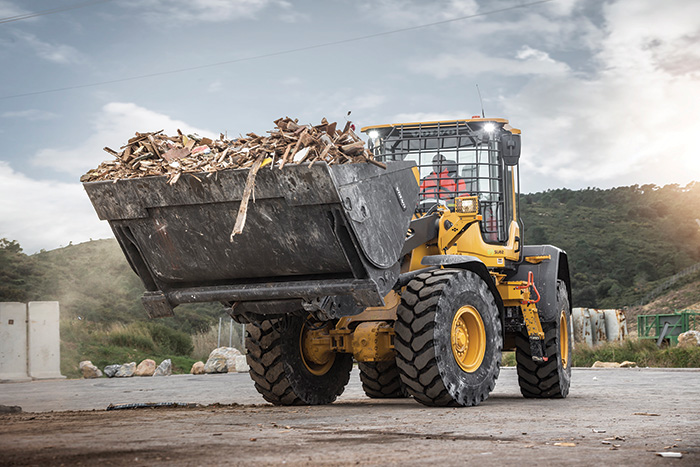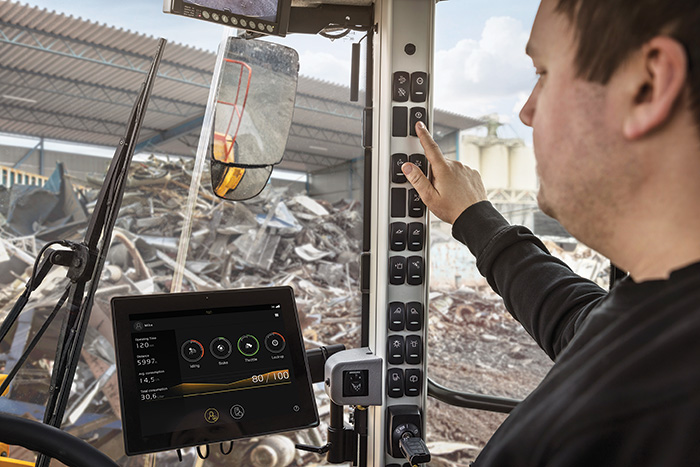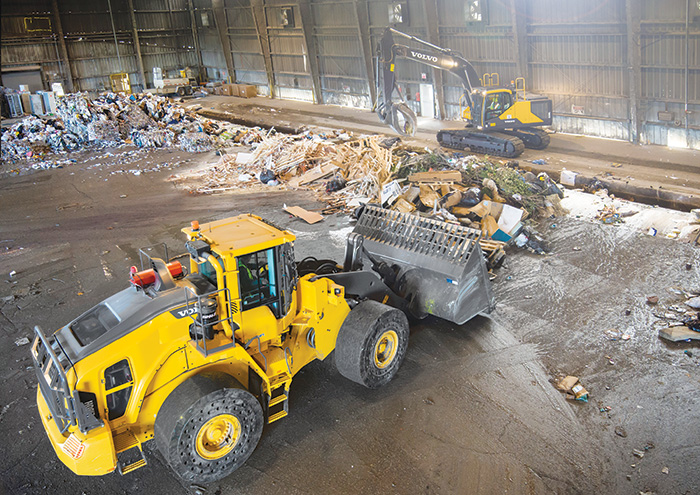Sharing perspectives on the latest, most helpful technology for loader owners and operators.
By Eric Yeomans
Today’s waste and recycling work demands more productivity and efficiency than ever, and there are a growing number of tools and equipment features to support owners and operators in getting there. I have been around wheel loaders for decades and seen a lot of innovation and development, so I am sharing my perspective on the latest, most helpful technology for loader owners and operators.
Monitoring Material Moved
Many OEMs now offer some type of assistive software to help operators and site managers know how much material has been moved. For example, Load Assist is a payload management system that eliminates the guesswork with the help of onboard weighing. With the ability to see real-time payload data accurate to within 1 percent, these systems can generate ROI by reducing labor, fuel, and administrative costs. That is because operators no longer have to waste time guessing, reweighing, or moving partial loads to get to the right amount. They will get the job done right the first time, use less fuel, and reduce wear on the loader.

Photos courtesy of Volvo Construction Equipment
Improving Fuel Efficiency
I mentioned fuel efficiency with the assistive technology, but there is another technological development that will make a big difference in saving time and fuel. Machine connectivity allows operators to see each other, see what routes are best, and see where any bottlenecks may exist. Connected Maps is a type of tool that can coordinate between in-cab tablets, phones, and computers, so different machines or roles in different locations can all work together to maximize the flow of a jobsite. Each site can be customized with points of interest like loading zones, dumping zones, one-lane roads, incidents creating problems, and even where the nearest restroom is. Operators can then make real-time adjustments to keep things moving, which reduces idle time and fuel consumption. This information can also help a site manager determine whether they have the right sizes and number of machines for optimal productivity.
Managing Work Orders
Software that helps manage work orders is just entering the market and will likely have a big impact on efficiency. Connected Loadout allows workers to place orders from the in-cab tablet or their phone. This can mean major time savings and the ability to bid work more accurately. Streamlining administrative processes not only supports productivity, but also leads to happier employees, and we are all looking for help in that department.

Supporting Operator Growth
First, let me say that there is no substitute for a solid operator training program or onboarding process. Tools and features that support their growth and productivity are great, but be sure to invest in training as well.
Many assistive programs come with operator coaching features that can point out when the operator might be using the wrong work mode or idling unnecessarily and a host of other behaviors. They can adjust accordingly and see the results in real time—some even take it as a competition against themselves to get better. Operators may think the technology is there so their bosses can watch their every move and micromanage them, but that is not what this is about. It is about maximizing safety, efficiency, and productivity, and making their day go as smoothly as possible. I often hear that once everyone has been properly introduced to and trained on the tech, they love it.
Keeping Everyone Safe
Another technology we will see more of in the very near future is collision mitigation. This is an automatic braking feature that helps reduce the risk or consequences of collisions when working in reverse. Wheel loaders spend 40 to 50 percent of their time working in reverse, so some extra “eyes” around the operator cannot hurt. Collision mitigation works by identifying when there is a risk of collision and automatically activating the brakes for two to three seconds, alerting the operator to intervene. It can be temporarily deactivated for specific site conditions.

Remembering the Simple Things
Most wheel loaders come with standard features that support the bottom line simply by being used correctly. For example, heated mirrors make it easy for operators to maintain maximum visibility and safety. A comfortable seat that is heated/cooled and can automatically adjust to different operators will reduce fatigue. An auto-lube system allows the operator to control the right amount of grease to each individual pin and bushing, simplifying maintenance and supporting uptime.
It is also worth considering whether aftermarket tech is the way to go or whether an OEM factory-installed waste or recycling package makes more sense for your operation. I recommend a package that includes telematics and/or a diagnostic system to support your loader’s uptime. The most advanced telematics systems can drastically reduce your time spent deciphering fault codes and preventing or repairing issues.
Do Not Be Afraid—Be Future-Ready
Contrary to what some believe, wheel loader technology is not here to steal jobs or spy on operators. It is here to make our lives easier, safer, and more profitable. Those who do not adapt might get left behind by the competition. If you have questions about the tech that might support your waste or recycling operation, connect with your dealer or OEM today. | WA
Eric Yeomans is Product Manager, Wheel Loaders for Volvo Construction Equipment. He has 45 years of experience in the construction equipment industry. He worked his way up from a mechanic apprenticeship at Volvo CE, when computers and displays did not exist, to managing GPE products and helping to develop the technology to make wheel loaders—and entire jobsites—function at their highest potential. Eric can be reached at [email protected].
